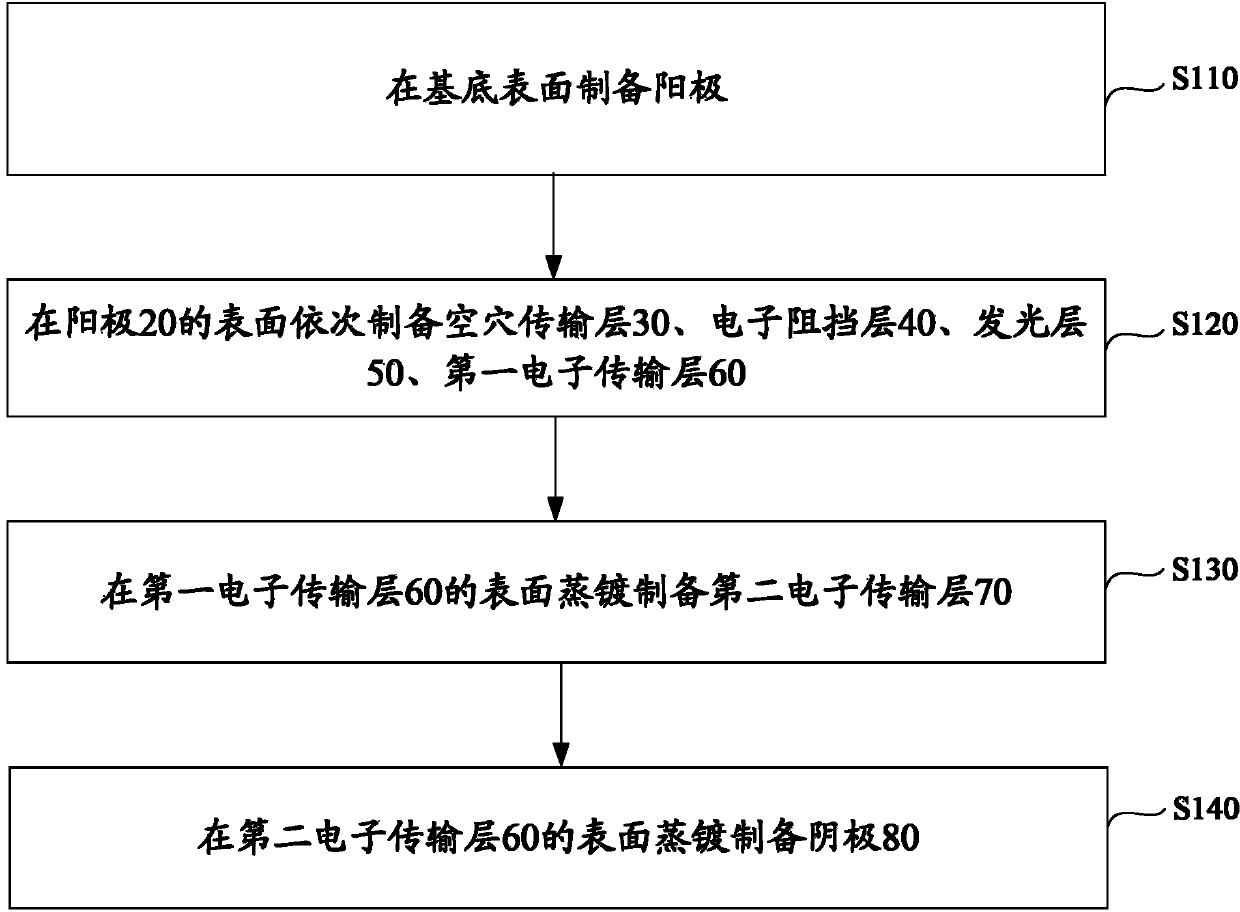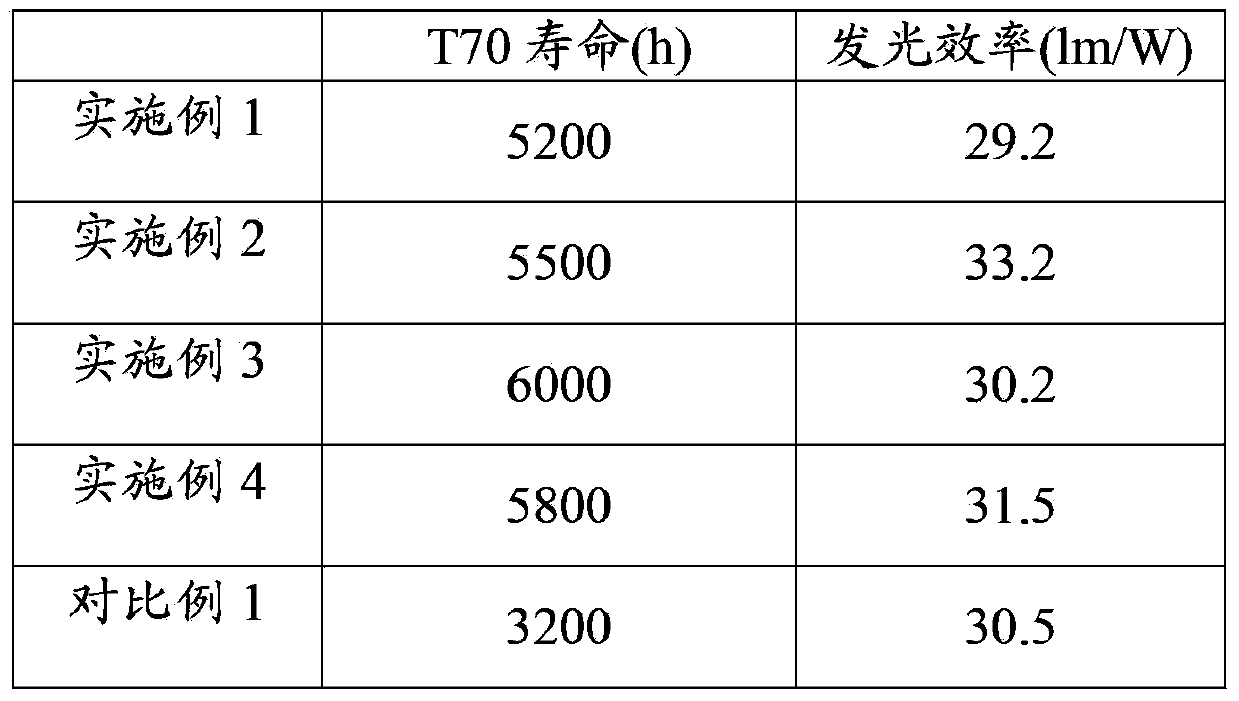Organic light emitting device and manufacturing method thereof
An electroluminescent device and electroluminescent technology, which are applied in the fields of electro-solid devices, semiconductor/solid-state device manufacturing, electrical components, etc., can solve the problems of low luminous efficiency and low electron transfer rate, and achieve high luminous efficiency and long service life. Effect
- Summary
- Abstract
- Description
- Claims
- Application Information
AI Technical Summary
Problems solved by technology
Method used
Image
Examples
preparation example Construction
[0033] Such as figure 2 As shown, the manufacturing method of an organic electroluminescent device according to an embodiment includes the following steps:
[0034] In step S110, an anode 20 is prepared on the surface of the substrate 10.
[0035] The substrate 10 is glass.
[0036] The substrate 10 is pre-treated before use. The pre-treatment includes: placing the substrate in deionized water containing detergent for ultrasonic cleaning, and then using isopropanol, acetone in ultrasonic waves for 20 minutes after cleaning, and then using nitrogen. Blow dry.
[0037] The anode 20 is formed on the surface of the substrate 10. The material of the anode 20 is indium tin oxide (ITO) or aluminum doped zinc oxide (AZO). The thickness of the anode 20 is 70 nm to 200 nm.
[0038] In this embodiment, the anode 20 is prepared by vacuum sputtering. When sputtering, the background vacuum is 1×10 -5 Pa~1×10 -3 Pa, the sputtering rate is 0.2nm / s~1nm / s.
[0039] In step S120, the hole transport l...
Embodiment 1
[0051] The structure of the organic electroluminescent device of this embodiment is: glass substrate / ITO(100nm) / F4-TCNQ: MeO-TPD(40nm) / TAPC(10nm) / Ir(ppy) 3 :CBP(10nm) / BEDT-TTF: NTCDA(30nm) / CsN 3 :TPBi(60nm) / Ag(100nm). Wherein, " / " means a laminated structure, and ":" means doping or mixing, and the following embodiments are the same.
[0052] In this preparation process, the working pressure of vacuum sputtering and vacuum evaporation is 1×10 -5 Pa, the vapor deposition rate of organic materials is 0.1nm / s, the vapor deposition rate of metals is 0.2nm / s, the vapor deposition rate of metal compounds is 0.1nm / s, and the sputtering rate of semiconductor oxide films is 0.2nm / s .
[0053] The preparation of the organic electroluminescent device of this embodiment is as follows:
[0054] Step 1. Provide a substrate, place the glass in deionized water containing detergent for ultrasonic cleaning, and then use isopropanol and acetone in ultrasonic for 20 minutes after cleaning, and then dry...
Embodiment 2
[0062] The structure of the organic electroluminescence device is: glass substrate / ITO(200nm) / F4-TCNQ: MeO-TPD(60nm) / TAPC(10nm) / Ir(ppy) 3 :CBP(20nm) / PyroninB: NTCDA(40nm) / Li 2 CO 3 :Alq 3 (10nm) / Ag(200nm).
[0063] In this preparation process, the working pressure of vacuum sputtering and vacuum evaporation is 1×10 -3 Pa, the vapor deposition rate of organic materials is 2 nm / s, the vapor deposition rate of metals is 2 nm / s, the vapor deposition rate of metal compounds is 0.5 nm / s, and the sputtering rate of semiconductor oxide films is 0.2 nm / s.
[0064] A manufacturing method of an organic electroluminescence device includes the following steps:
[0065] Step 1. Provide the substrate; place the glass in deionized water containing detergent for ultrasonic cleaning, and after cleaning, treat it with isopropanol and acetone in ultrasonic for 20 minutes, and then dry it with nitrogen;
[0066] Step 2: When the vacuum degree is 1×10 -3 In the Pa vacuum coating system, the magnetron sputte...
PUM
 Login to View More
Login to View More Abstract
Description
Claims
Application Information
 Login to View More
Login to View More - R&D
- Intellectual Property
- Life Sciences
- Materials
- Tech Scout
- Unparalleled Data Quality
- Higher Quality Content
- 60% Fewer Hallucinations
Browse by: Latest US Patents, China's latest patents, Technical Efficacy Thesaurus, Application Domain, Technology Topic, Popular Technical Reports.
© 2025 PatSnap. All rights reserved.Legal|Privacy policy|Modern Slavery Act Transparency Statement|Sitemap|About US| Contact US: help@patsnap.com



